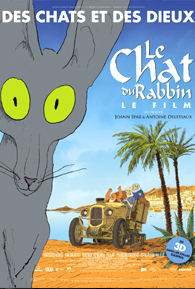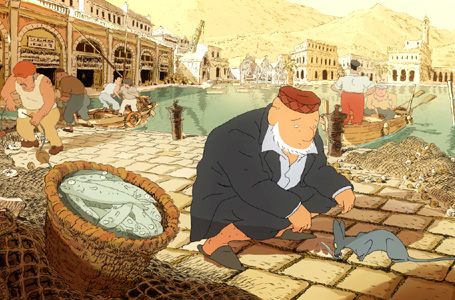
It was just a matter of time before his talents were transferred to the screen, after a biopic of singer Serge Gainsbourg, his second effort is a filmed version of one of his most famous graphic novels, The Rabbi's Cat.
It's Algeria in between the wars, and all religious communities live harmoniously in Algerie Francaise. The dark-skinned, Arab-speaking Sephardic Rabbi Abraham Sfar is studying for a dictation exam to show his mastery of French while trying to raise his beautiful daughter Zlabya (Hafsia Herzi) singlehandedly. Then one day his cat swallows his parrot, gains the power of speech, and demands to be converted to Judaism. A box also comes to Algeria from Russia, and inside it is a young Russian lad, a blonde, blue eyed Ashkenazic Jew fleeing the pogroms and longing to find the New Jerusalem in Africa. Along with his friend Vastenoy, a drunken, womanizing, ex-military Czarist, they head on a voyage across Africa in a beat up old army halftrack to find a lost city where the descendants of Solomon and Sheba dwell. Joining them is Sheikh Sfar, Rabbi Abraham's Muslim equivalent, who also has a talking donkey.
The result is a sort of existential Indiana Jones adventure that also serves as sort of examination of the Jewish question a.k.a. "Who Is A Jew?" Sfar argues that it is too fluid and diverse an identity, and not to be shoehorned into being a race or a nationality; represented by its cast: there are dark-skinned Sephardics that speak Arabic rather than Hebrew in their sermons and light-skinned Russian-speaking Ashkenazis who hold loyalty to Czar Nicholas rather than King David, and in its titular rabbi's cat, a beast that wants to become Jewish, and a plan for a Zionist homeland in Africa rather than the Middle East.
The film's simplistic argument that all faiths should live and let live rather than waste time on declaring others infidels or blasphemers and simultaneous celebration of the Jewish identity and its fluidity is thankfully rarely preached upon as much as it is shown. There is a third act that is a delight to see, in which the New Jerusalem is finally discovered, and the art turns into a superdeformed style that might not be out of place in the animated segments of Sesame Street. That segment is a prime example of what only animation can do: boil a concept down and distill it to its essence. The hilarious sequence resulting reveals the plain absurdity of any religious attempts to 'uncover the true faith': given the long stretches of history, the true faith may in fact be a 'foreign country' to even the most fervent believers today.
The film's weakness is arguably its characters, who are mostly hastily drawn one-note personalities, even the titular cat. However, its dazzling, diverse animation makes a great display in showing the talents of one of the brightest stars in the French comic firmament.












 Printable Version
Printable Version










Reader's Comments
Be the first to leave a comment on this page!
Please log in to use this feature.